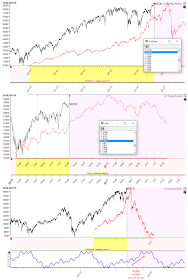 |
| Enlarge |
I believe that we are terminating an impulsive advance from an Elliott wave perspective, this impulsive advance is the fifth wave of grandsupercycle degree [...] Another scary aspect of the chart above is the extended fifth wave that occurred from the lows in 1974 to where we stand today. R.N. Elliott warned about what usually occurs after a fifth wave extension since it is usually followed by a crash. Once we look at the projection lines we will notice such an outcome is highly likely based on our volatility forecast. The target for the correction after a fifth wave extension is the range of the second wave which brings us to the 1000-770 price range. Such a forecast for the Dow is certainly scary and I am not brave enough to make such a cataclysmic call which is why I will wait for the patterns to unfold to obtain more accurate price targets. It is important to know that the US stock market is likely to be the out-performer as indicated in one of my previous posts (The American S&P and German Dax ratio) in which I analyzed a ratio of the DJIA with the German DAX. If such a target is expected in terms of the DJIA one can only imagine what will occur to the European indices. I still prefer a German DAX short once the peak is in since one will make money from a higher EURO and a larger percentage drop. Let us now take a look at the shorter term wave count.
The shorter term wave count suggests that the DJIA is in its fifth wave of intermediate degree to terminate the primary degree rally from 2009 which will in itself terminate a cycle degree advance that started in 1974 which will itself terminate a supercycle degree advance that started in 1932 which will itself terminate a grand supercycle degree move that started in 1784. The cycles mentioned on many previous posts on this blog support that fact. I believe that such a large and historic top will end in weakness rather than strength. This is why I am preferring an ending diagonal scenario for the fifth wave of intermediate degree. I am certain that the correction that is about to unfold will be the largest correction in US history. This is a time to be cautious from equities and to try our best to avoid the calamity.
The first chart below presents an overlay of the 1920s bull market with the one seen since late 2011. Both bull markets occurred under a similar cyclical circumstance hence their high correlation (9 year cycle). The correlation is almost 80%! This projection line suggests that a peak is likely in the first quarter of next year. This conclusion is supported by a projection line of the 18 month cycle that started in 1971 which is presented below.
 |
| Enlarge |
The third chart above shows my volatility projection as well as the projection line of the late 20's. The volatility indicator was obtained from two 9 year cycles of a similar cyclical circumstance to where we stand today. The volatility projection suggests that the crash is likely to be drastic going into the low that is expected in 2020 which is when peak volatility is expected.